Headlines and Hashtags
“This Does Not Need to Be Featured”

One of the top-trending stories this week in China has been the tragic crash of China Eastern Airlines flight MU5735, en route from Kunming to Guangzhou, near the city of Wuzhou, Guangxi province. The worst air crash in China in 20 years, the story has been dominated by state media, which have focused on the government’s response since Xi Jinping called for a rapid recovery effort and swift investigation.
But there have also been a few notable exceptions in coverage, online and through social media accounts — and one in particular has prompted a discussion of when it is appropriate to show the human side of tragedy.
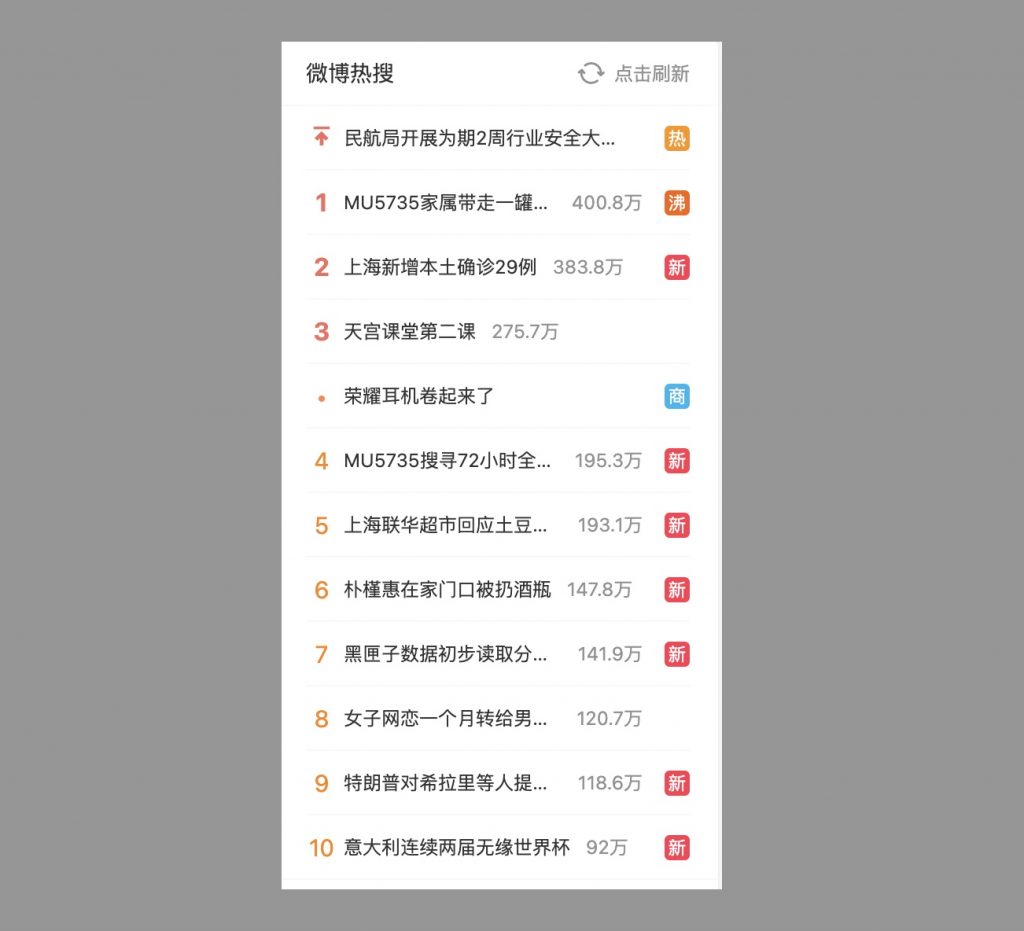
Beginning with newspaper coverage, a CMP review of coverage over the past four days using a database of mainland Party and commercial newspapers – with a total of 314 articles since the crash occurred on March 21 – found that the vast majority of coverage was sourced from either Xinhua News Agency or China News Service, the country’s official news wires. Several reports from the Global Times, a tabloid spin-off of the Party’s official People’s Daily newspaper, and from the People’s Daily were also cited alongside CCTV, the national broadcaster.
Reports appearing in regional and national newspapers most frequently cited Xinhua, including such commercial papers as the Yangcheng Evening News (羊城晚报), Southern Metropolis Daily (南方都市报) and New Express (新快报) in Guangzhou, Jiangxi’s Jiangnan Metropolis Daily (江南都市报), Hubei’s Chutian Metropolis Daily (楚天都市报), the Shenzhen Special Zone Daily (深圳特区报), as well as regional Party-run papers such as Zhejiang Daily (浙江日报) and Shantou Daily (汕头日报).
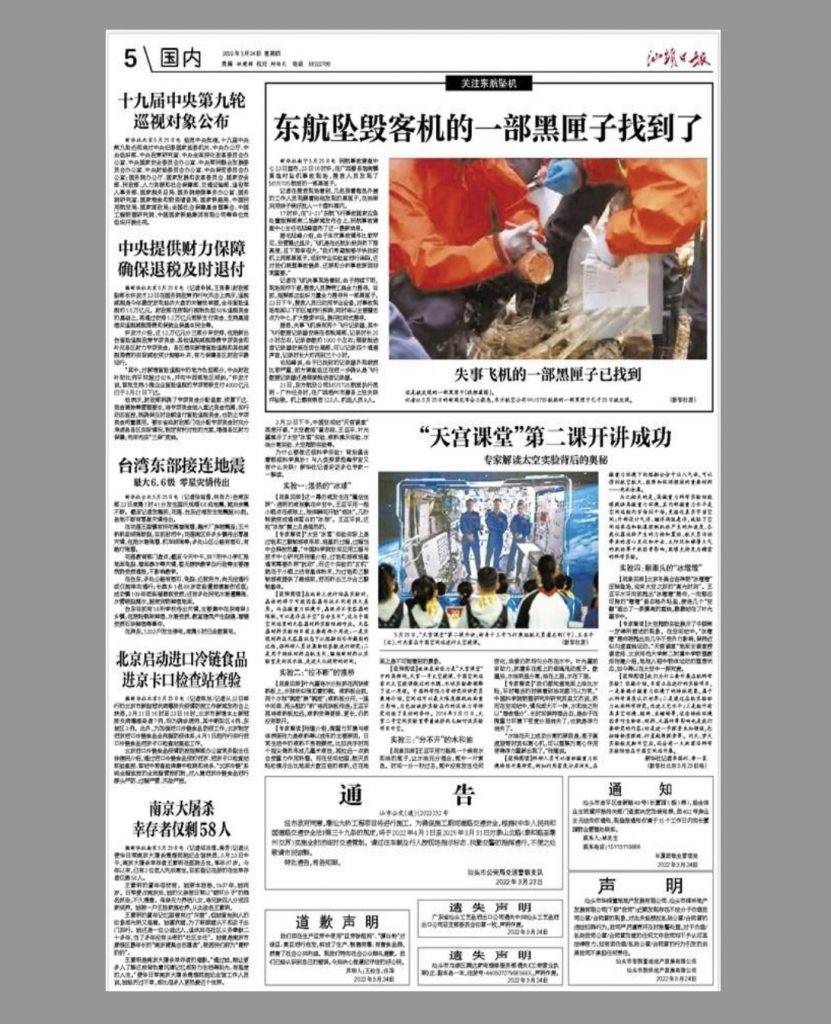
While sourcing for coverage of the crash was generally uniform across Chinese newspapers, the primary difference was treatment and emphasis in using officially released information. At commercial newspapers, the story was generally given more creative front-page treatment from March 22, while Party newspapers either pushed the news to inside pages or hemmed it in on the front page with other Party and government-related news stories.
On March 22, for example, the official Hubei Daily (湖北日报), the CCP mouthpiece in Hubei province, reported Xi Jinping’s “important instructions” (重要指示) on the crash response under the masthead, but without accompanying images. The news was surrounded by other official announcements, such as an “opinion” from the CCP Central Committee on the study of Party history, and the holding of a provincial government meeting on agricultural policy.
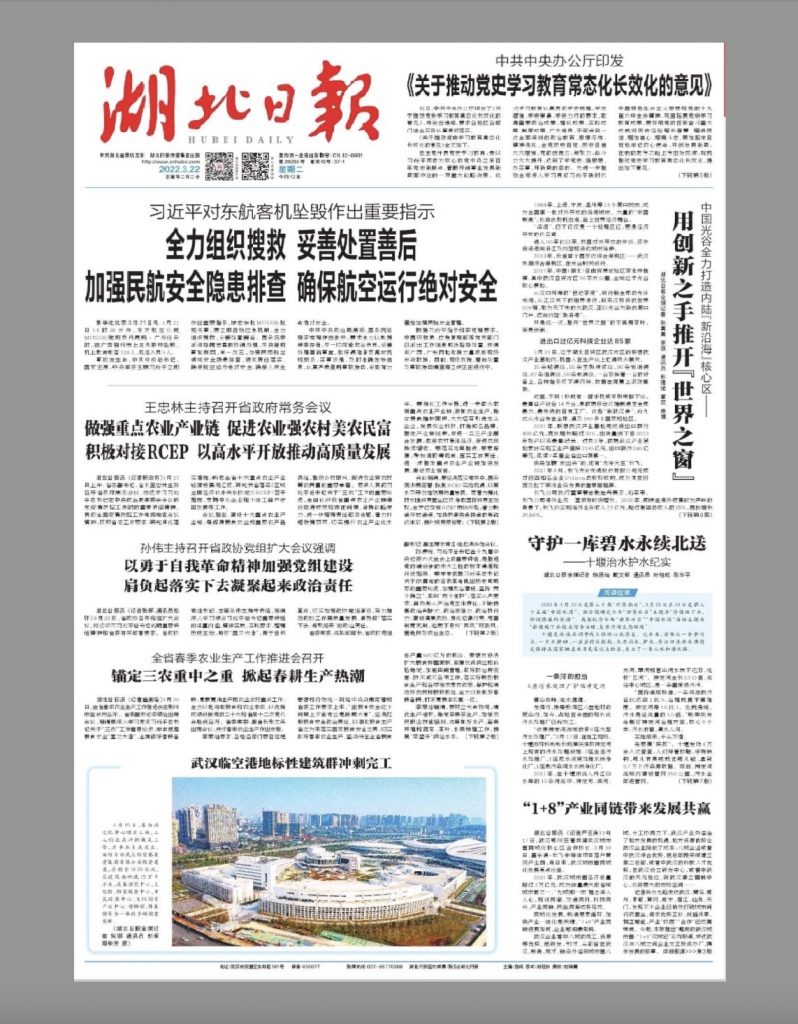
By contrast, the Party paper’s commercial spin-off, Chutian Metropolis Daily, devoted nearly its entire front page to the crash of flight MU5735, including images of the crash area and the ongoing search as well as a map of the flight path.
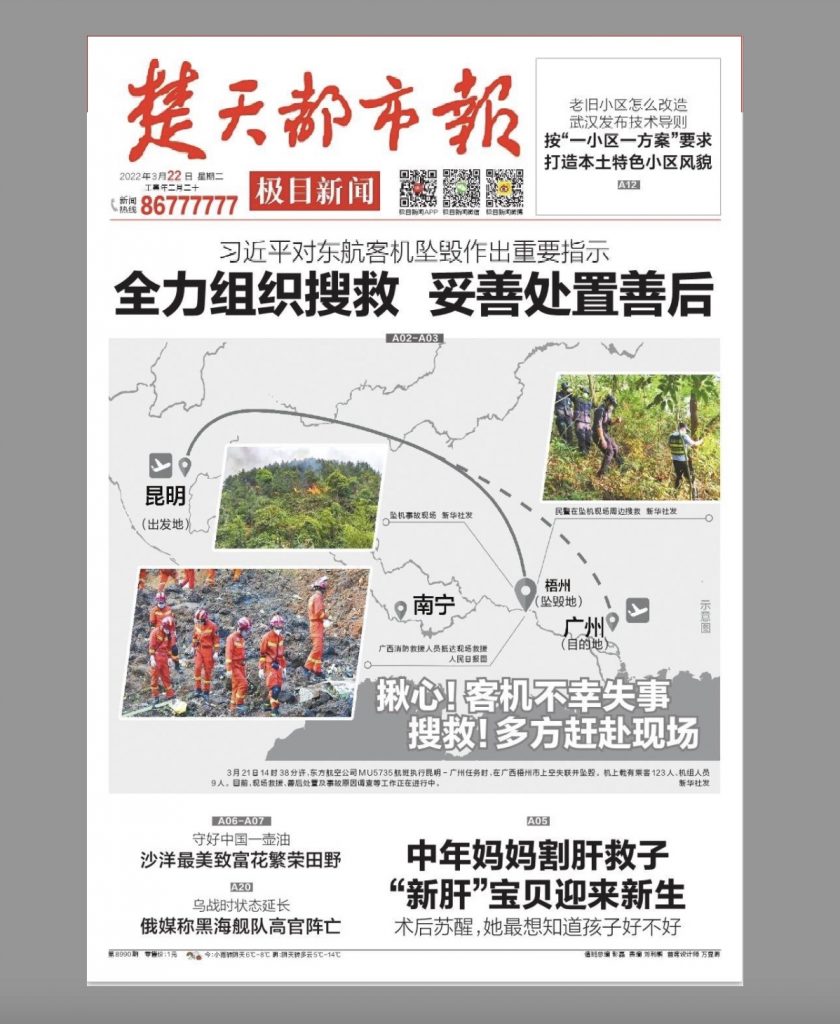
The top headline at Chutian Metropolis Daily, however, remained Xi Jinping’s “important instructions,” and the related Xinhua report was typical of coverage since, focusing on the efforts of the leadership and crews on the ground:
At 14:38 on March 21, Eastern Airlines flight MU5735 was lost and crashed over the city of Wuzhou, in Guangxi, while en route from Kunming to Guangzhou. There were 123 passengers and 9 crew members on board. After the incident, General Secretary Xi Jinping immediately issued important instructions, requiring the organization of search and rescue, proper handling of the aftermath, and an investigation into strengthening civil aviation to ensure absolute safety of flight operations.
The crash has touched the hearts of the people. At present, the scene rescue, aftercare and investigation of the cause of the accident is underway. As long as there is a ray of hope, we must expend one-hundred times the rescue effort. At the same time, the cause of the accident must be identified as soon as possible.
Reactions and discussion of the flight crash online and on social media have been far more varied, with millions expressing shock and concern over the tragedy. Early on, many expressed their fondest hopes for a miracle for the 132 lives on board, even if the conditions of the crash offered little hope. Many posted digital candles to Weibo and other platforms.
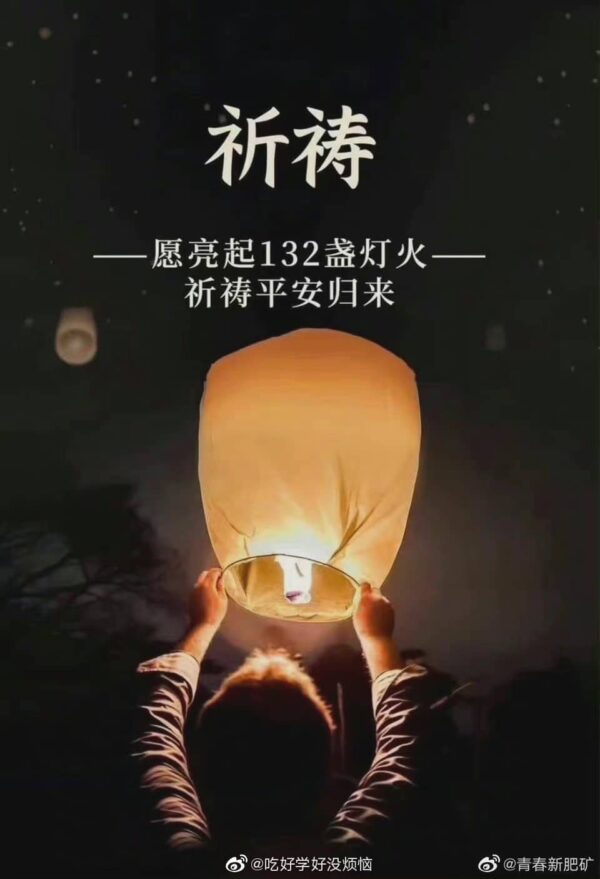
Focusing on Humanity
One of the most notable exceptions to the Xinhua-led official state media coverage of the MU5735 tragedy was also one of the most controversial this week. The story, called “The People of Flight MU5735” (MU5735航班上的人们), was published on March 22, the day after the crash, through the official WeChat public account of Ren Wu (人物), or “People,” a monthly Chinese magazine whose English-language tagline has long been, “Nothing But Storytelling.”
The magazine, which is published by the state-run People’s Press (人民出版社), reached out to families, friends and colleagues of the passengers aboard flight MU5735, as well as sources in Guangxi province who witnessed the crash. Based on these interviews, the magazine pieced together a feature story that sought to personalize and humanize the victims of the crash and those close to them.
One part of the story concerned passenger Liu Zhihong (刘志宏), who happened to keep his own WeChat public account on which he regularly posted articles about his relationship with his wife and their romantic moments. The feature story read:
On board this one hour and 55-minute flight was frequent flyer Liu Zhihong. The day before he boarded the plane, Liu Zhihong had just received his wedding photos. 2022 had been the start of his new life. That day was meant to be just another brief and routine separation from his new wife. . . .
The latest article [on Liu’s WeChat account] was from December 26, 2021. He had shared an image of his marriage certificate at the end of the post. In the image, “Ms. Trees,” his pet name for his wife, wears a white top, and “Mr. Red Bean,” this being his own nickname, wears a grey suit and striped blue necktie. They both smile before the camera. At this point in their relationship they had already given a name to their future child: Liu Zhinian.
The Ren Wu article also painted a picture of one passenger’s friends waiting for her to disembark in Guangzhou, where they were ready with her birthday surprise. There was the story of a teacher who had completed a business trip to Kunming and was looking forward to his return home to see his three sons.
Between the raw emotion over the MU5735 story on social media and the dry, mechanical reporting of the government’s we-will-stop-at-nothing response in state media, the Ren Wu feature was certainly a stand-out piece of storytelling. But some wanted to know: Was this really the time?
Many netizens criticized the story on the grounds that such intimate reporting violated journalistic ethics by capitalizing on the trauma of those close to the victims. Another WeChat public account, “Media Tea Party” (传媒茶话会), responded with its own feature discussing the ethical issues raised by the Ren Wu story. The article gathered views from several media scholars and journalists.
Those in support of the magazine felt that the fact that the names of victims had not yet been officially released was not a valid reason to desist from related reporting. “The fact that officials have not released the list of those killed or lost should not be a reason to stop reporting on the victims, nor should such a release be considered a prerequisite, otherwise many reports will not be able to move forward,” said Gu Xiaojin (辜晓进), a professor at Shenzhen University’s School of Communication. “Sometimes, life and death questions aren’t resolved for some time after a major disaster, but that doesn’t mean the media should do nothing and stop following up.”
Another “senior media figure” who remained unnamed told “Media Tea Party” that reporting on the passengers whose lives were lost is simply part of the process of presenting the truth of the incident. At times, such reporting can actually be helpful in explaining the causes of an event, they said. Moreover, such reporting was a special form of remembrance, not unlike the obituary, allowing the dead to be remembered.
Huang Chuxin (黄楚新), a researcher at the Institute of Journalism and Communication of the Chinese Academy of Social Sciences, had three primary objections to the Ren Wu feature story.
Interestingly, Huang’s first objection adhered quite closely to the official state media approach to reporting, and therefore was less a point on ethical conduct and more a point on historical practice and Party media norms. In the early stages of a disaster, he said, the media should first focus on the elements (要素) of the disaster itself — including its cause, the nature of the disaster response and relief and information to help the public “understand the truth about the accident.”
Second, Huang felt that the Ren Wu story had been guilty of “consumption of other people’s suffering.” And finally, he was of the view that it was more responsible at this early stage for media to simply “keep their distance,” and focus on “news value” over personalities and narratives.
Another source quoted in the “Media Tea Party” article, identified as a senior manager for a central-level media outlet, similarly conveyed the view that it was too early to report on the more intimate aspects of the MU5735 tragedy. “The rush to pick apart the story of the people on board for everyone to see, to carve out the strange details and to create pathos, all of this satisfies the desire to tell the story and see the story,” they said. “But this is an accident, and the time has not yet come to tell stories without the slightest hint of public character.”
In using this term “public character” (公共性), the central media source meant something akin to, but notably different from, the idea of the public interest. Generally, in China’s official news culture, under the strictures of the CCP’s view of the news, the government response is the news, period. The leadership is anxious to ensure that the initial news cycle is dominated by stories of government action and heroism – and that questions of negligence or responsibility are sidelined or buried. Frequently, once the initial period of response is finished and an official investigation underway, media are told that the time has passed for reflection. Propaganda instructions will often explicitly direct media not to “reflect back” (回顾).
It is often the case in China that once the initial period of response has passed, with formal commemorations on day 7 following a tragedy, the window of opportunity has already closed. Under a system of official news controls, it is always too early or too late for substantive coverage.
Another Shenzhen University professor, Peng Huaxin (彭华新), took issue with the assertion that all information about the victims and their family members should remain private. While the right to privacy involved the protection of certain private information as well as the dignity of a person, the release of certain information could also be of public concern in the event of such tragedies, he said. “Obviously, the people in this sudden tragedy are figures for whom most of the nation now feels concern and attachment, and the publication of their names is also done out of respect or a sense of grief for them,” said Peng. “There is nothing wrong with the moderate disclosure of their names, which does not include any negative information or personal insult.”
Comments from internet users responding to the Ren Wu story were a mix of critical and supportive.
“[The story is] well written, but the piece comes at a bad time,” said one respondent. “Before there has been any official confirmation [that the passengers have died], this article is basically telling everyone, ‘Yes, these people have passed away, come and remember them.’”
Another user asked: If not now, when? “To put it politely, it’s a non-issue to discuss the timing of coverage, as though Chinese media have any freedom to decide when to report anything,” they wrote. “The reality is that if you don’t report it now, you may not get a chance to do so later, so it’s natural to do whatever you can.”
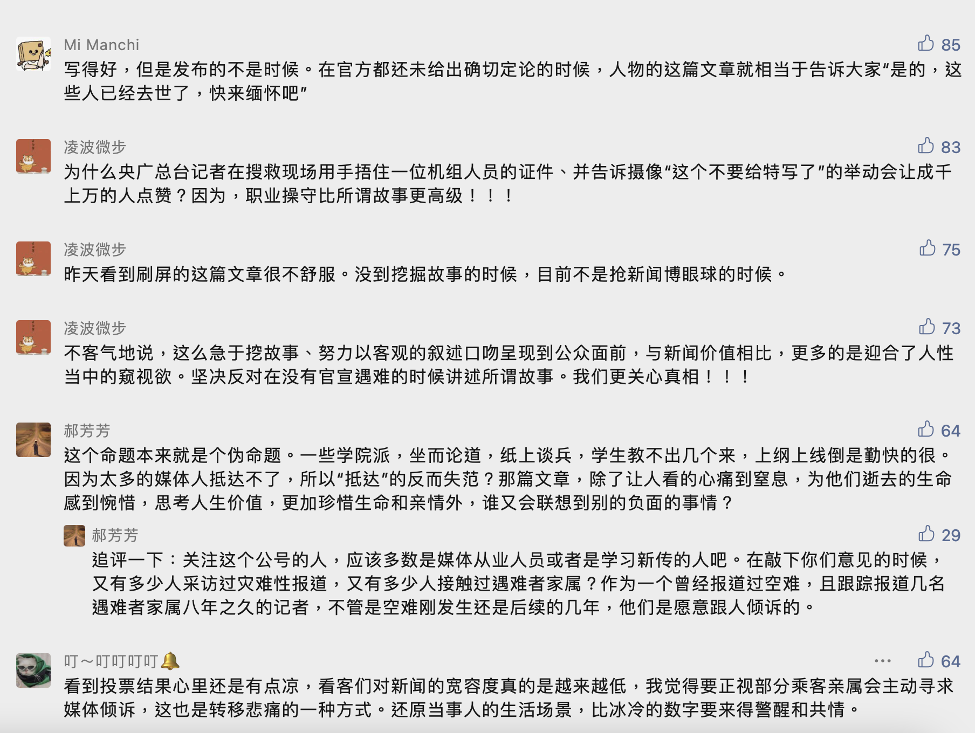
In fact, the Ren Wu magazine story had not been the only of its kind. The next day, March 23, the China Youth Daily (中国青年报), published by the Communist Youth League, released a story online based on an interview with the sister of a passenger on MU5735. She told the paper about how her sister and brother-in-law had gone to Kunming to seek treatment for their daughter’s illness, and all three were aboard. While the narrative was sympathetic and sentimental, not unlike the Ren Wu story, one difference was the paper’s emphasis from the outset on the sister’s willingness to speak. The headline of the piece read like a disclaimer: “I Am Willing to Say: My Sister and Brother-in-Law Were on the Plane with My 1.5 Year-Old Niece.”
The same day as the China Youth Daily online story, the Party’s official People’s Daily published a commentary on the media’s role in covering the crash. It spoke of holding to the “moral bottom line” (道德底线) and abiding by “journalistic ethics” (新闻伦理). The article singled out for praise a reporter for the state-run China Central Television, who during a live broadcast on March 22 had asked that the cameraman focus away from a flight attendant’s ID card found at the crash site, wishing to protect the privacy of the victims.
“There is a need to keep as much as possible to the moral bottom line and follow journalistic ethics when presenting valuable information,” the People’s Daily article said. “But the privacy of the people on board should not be excessively explored in the name of reporting, nor should the need to report constitute an intrusion on the family and friends of those on board.”
The CCTV reporter’s action quickly became the story on March 23, drawing the focus away from the victims and back to one of a number of official narratives. A still image of the CCTV broadcast was shared by the network on social media, the reporter’s hand covering an ID in the dirt, with the caption: “This does not need to be featured.”

Additional research by David L. Bandurski.




















